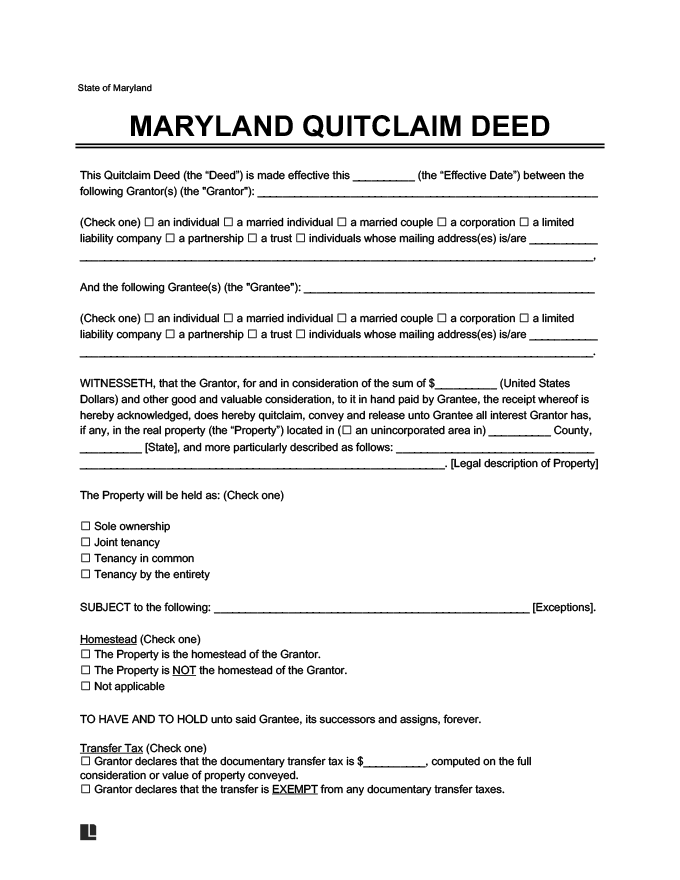Transferring property via a quitclaim deed in Maryland involves a detailed process that’s specific to its legal requirements. Here’s how to go about it:
- Step 1 - Obtain Maryland Quitclaim Deed Form
- Step 2 - Enter Preparer's Details
- Step 3 - Enter Grantor's Details
- Step 4 - Enter Grantee's Details
- Step 5 - Fill in Consideration
- Step 6 - Note Property Legal Description
- Step 7 - Preparer Signs the Form
- Step 8 - Grantor Signs the Form in Front of a Notary Public
- Step 9 - Prepare Land Instrument Intake Sheet
- Step 10 - File Documents with Circuit Court Clerk
Step 1 – Obtain Maryland Quitclaim Deed Form
Download the appropriate quitclaim deed form. You can use a Maryland-specific quitclaim deed template to ensure the format and contents follow all applicable state laws. You may also decide to hire a Maryland property attorney to guide you throughout this process.
Step 2 – Enter Preparer’s Details
The preparer of the document may be the grantor or a qualified attorney. Under “Prepared by,” the preparer should enter their name and address.
Step 3 – Enter Grantor’s Details
Enter the full, legal name of the person who is giving the property, known as the grantor. Then, enter their mailing address.
Step 4 – Enter Grantee’s Details
Enter the full, legal name of the person who is receiving the property, known as the grantee. Then, enter their mailing address. Note that the document should be returned to the grantee after filing, unless you would like it to go elsewhere.
Step 5 – Fill in Consideration
After the words “in consideration of the sum of” in the main content portion of the deed, add the amount paid, if any, for the property. First, write out the words, then add the numeric value in the parenthesis after the words. You may choose to record a nominal amount here, which is a small symbolic amount of money like $10.
Step 6 – Note Property Legal Description
Provide the property’s county. Then, write the property’s legal description, including its address, plot number, and complete property description noting uniquely identifying elements of the property. Find the description on the previous property deed and add a second document including this more in-depth description as an attachment.
Step 7 – Preparer Signs the Form
In the “Preparer’s Certification” section, the person who prepared the document must enter their status and signature. If the party is not an attorney, they will declare their status as grantor or grantee. After signing, the preparer must also print their name.
Step 8 – Grantor Signs the Form in Front of a Notary Public
The grantor must sign the document in the presence of a notary public who certifies the authenticity of the signature.
Step 9 – Prepare Land Instrument Intake Sheet
Prepare a land instrument intake sheet, which must accompany a Maryland quitclaim deed. The land instrument intake sheet requires the preparer or grantor to fill out information like:
- The type of deed attached
- Tax exemptions and calculations
- New and existing mortgage amounts
- The property purchase price and consideration
- Calculation of all related filing fees
- An in-depth description of the property’s location, type, size, tax information, and more
- Names of the grantor(s) and grantee(s) involved
- Any other names to be indexed in regard to the deed
- Contact information for preparer, whether that be the grantor or an attorney
- Answers to questions about the assessment of the land
According to the form, both the original deed and a photocopy must accompany it in order for it to be properly processed and filed.
Step 10 – File Documents with Circuit Court Clerk
Submit the completed, signed documents with the Maryland clerk of the circuit court in the property’s county, along with any appropriate fees.
